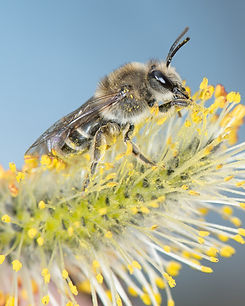
Family Apidae
Apidae
The family Apidae is a highly variable family of bees that includes some of the largest bees in the state within the genus Bombus (bumble bees) and Xylocopa (carpenter bees), as well as many genera of cleptoparasitic (cuckoo) bees including Brachymelecta, Epeolus, Holcopasites, Neolarra, Nomada, and Triepeolus. Bees in this family nest in a variety of locations including in or on the ground, in wood, and in plant stems or cavities in other natural substrates.
The sociality of the bee genera and species in this family is also highly variable; for example, Bombus and Apis having social nests and the majority of the remaining genera having solitary nests. Bombus and Apis females have pollen baskets (corbiculae), an enlarged and concave-shaped hind leg tibia used for transporting pollen loads. However, the other ground-nesting bee females in the family Apidae within the genera Anthophora, Epimelissodes, Eucera, Melissodes, and Xenoglossa are robustly shaped and have lengthy pollen-collecting hairs (scopae) on their hind leg tibiae and basitarsi; males have long antennae (long-horned).
The family Apidae also includes a small number of pollen-collecting specialists (oligolectic bees), many of which are active in the summer or early autumn specializing on pollen from plants in the family Asteraceae.

Bombus auricomus (black and gold bumble bee) is one of the largest bees in Minnesota.

Melissodes denticulatus is a pollen specialist of Vernonia.
Family Characteristics

3
1
2
Three forewing submarginal cells.
Medium to long glossa (tongue) 5-16 mm
Family with largest percentage of cleptoparasitic (cuckoo) bees
Corbicula (pollen basket) present for two genera (occurring in Minnesota)

Pollen collecting hairs (scopae) on
hind tibiae and/or basitarsi (females).
Explore Apidae Genera
Explore Bee Families

Apidae
15 genera, 133 species
Bumble bees Bombus
Longhorn bees
Epimelissodes, Eucera, Melissodes
Carpenter bees
Ceratina, Xylocopa
Honey bees Apis
Digger bees Anthophora
Cuckoo bees Brachymelecta, Epeolus, Holcopasites, Nomada, Neolarra, Triepeolus
Squash bees Xenoglossa

2 genera, 39 species
Halictidae
10 genera, 133 species
Metallic green sweat bees
Agapostemon, Augochlora, Augochlorella, Augochloropsis
Large sweat bees
Dieunomia, Nomia
Short-faced bees Dufourea
Sweat bees Halictus
Small sweat bees Lasioglossum
Cuckoo (blood) bees Sphecodes
Megachilidae
14 genera, 86 species
Resin and pebble bees Anthidiellum, Dianthidium, Heriades, Paranthidium
Carder bees Anthidium, Pseudoanthidium
Mock orange bees Chelostoma
Mason bees Osmia, Hoplitis
Leafcutter bees Megachile
Sharp-tailed cuckoo bees Coelioxys
Dark cuckoo bees Stelis

Citations and Further Reading
Droege, S., Shumar, S., & Maffei, C. (2024). The Very Handy Bee Manual (2.0). Zenodo. https://doi.org/10.5281/zenodo.12812755
Mitchell, T. B. (1960). Bees of the eastern United States. Technical Bulletin No. 141. North Carolina Agricultural Experiment Station.
Portman, Z. M., Gardner, J., Lane, I. G., Gerjets, N., Petersen, J. D., Ascher, J. S., ... & Cariveau, D. P. (2023). A checklist of the bees (Hymenoptera: Apoidea) of Minnesota. Zootaxa, 5304(1), 1-95.
Wilson, J. S., & Messinger Carril, O. J. (2016). The bees in your backyard: a guide to North America's bees. Princeton University Press.



















